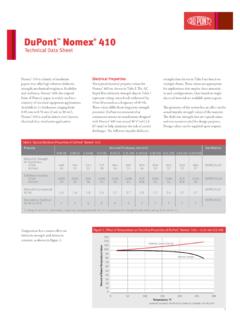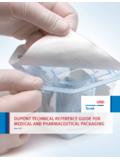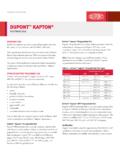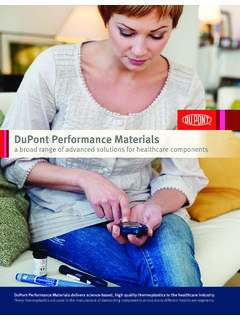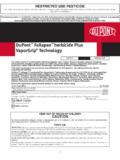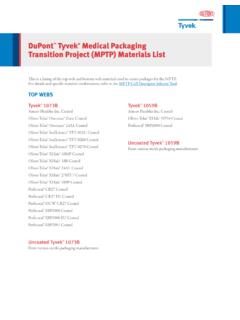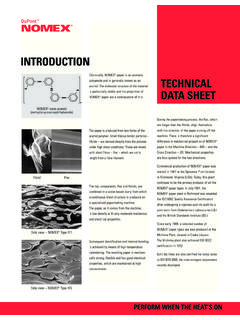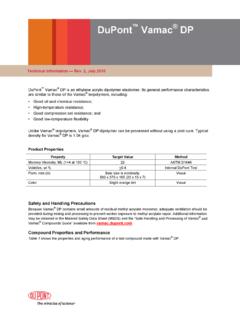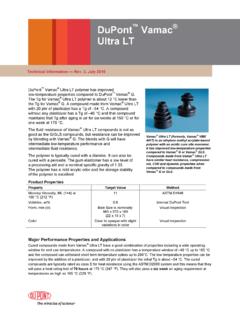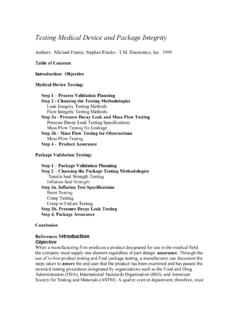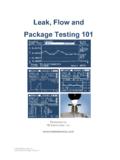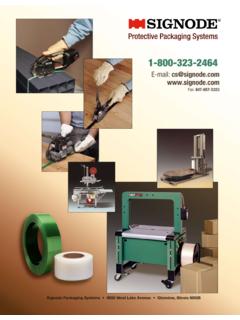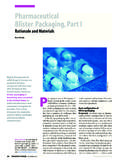Transcription of Bonding “Unjoinable” Polymers - DuPont
1 DuPont Packaging & Industrial Polymers Bonding unjoinable Polymers WHITE PAPER. I Hwa Lee, Technical Fellow DuPont Packaging Introduction Although almost everything consumers buy comes in a package, they seldom give packages a second thought . unless there is a problem. Consumers take a lot for granted in their soon-to-be-discarded packages: convenience, product protection, shelf life, damage resistance and tamper evidence, for example. The package must perform on the packager's filling lines, as it moves through distribution, on the store shelf and in the consumer's hands. The diverse requirements throughout the value chain can be met by using multilayer structures containing a variety of Polymers to perform different functions or combinations of functions.
2 Multilayer Packages Every multilayer package needs a structural Figure 1. Typical Barrier Structure polymer that's strong and tough, has the right degree of flexibility or rigidity and provides bulk. inside This material is frequently the outside layer of the package, so it has to look good, and feel right. Surlyn Ionomer In many cases it has to accept high-quality Bynel Tie printing, or be laminated to a reverse-printed Nylon oriented substrate. EVOH. Nylon Bynel Tie Most film structures are fabricated into a package by some form of heat-sealing of the inside layers to each other along the package perimeter. This PE. polymer must seal reliably on a high-speed package forming and filling line, resist Nylon degradation by the product itself and, in the case outside of food packages, comply with regulatory requirements for food contact.
3 In some cases, an easy-opening seal is an important additional requirement. Bonding unjoinable Polymers - 2- Food packages often need a highly impermeable gas Figure 2. What Sticks and What Doesn't and flavor barrier to maintain freshness and to extend shelf life. Polar Polymers such as ethylene vinyl er er m e olym m er ylen alcohol or nylon serve that purpose. MA. Iono ne r I ono styre or E. Cop pr op este ium n6. H. E. E. HDP. EVO. Nylo EVA. Poly Poly Poly LDP. Acid Zinc S od Other polymer layers may be added to provide better formability or to improve toughness of the package. Polyester z EVOH z z Nylon 6 z z z Adhesive layers are essential whenever the different Polystyrene z z materials in the structure don't adhere to one another.
4 Polypropylene z z HDPE z z z LDPE z z z Figure 1 shows a typical multilayer structure of a EVA or EMA z z z z z Good Zinc Ionomer z z z Fair package. Sodium Ionomer z z Poor Acid Copolymer z Figure 2 shows a grid of Polymers commonly used in packaging. The diagonal at the right of the grid, marked by filled circles, shows good adhesion when Polymers stick to themselves. The other filled circles on the grid show dissimilar Polymers that bond well to each other. However, much of the grid shows polymer combinations with poor affinity for each other. For example, it is possible to coextrude a polyester with an acid copolymer, but these layers easily separate from each other. Adhesion Solutions from DuPont To hold incompatible Polymers together, DuPont has developed a variety of solutions to adhesion needs.
5 Most of them are part of the DuPont Bynel family of extrudable adhesive resins. Other DuPont products such as DuPont Surlyn ionomer, DuPont Nucrel acid copolymers and DuPont Entira coat resins can also act as Bonding agents. The Bynel portfolio contains more than 50 individual grades using various chemistries and technologies. They are formulated to provide and maintain the adhesion level critical to package integrity at every stage of manufacture and use: film production and converting, package forming, distribution and use by the consumer. Bynel can work in film coextrusion processes including cast film, blown film, double bubble and coextrusion coating. Thermal lamination of films containing Bynel resins is also an option.
6 Rigid extruded product processes using Bynel include cast sheet, blow molding, tubing and pipe. Bynel grades for multilayer injection molding and injection stretch blow molding are also available. The adhesion level in a multilayer structure depends on three factors in addition to the composition of the tie layer, , Bynel . First, the design and structure of the multilayer package affects bond strength. Changes in tie layer thickness, total film thickness, polymer type, and additives such as anti-fog agents, for example, can alter adhesion level. Bonding unjoinable Polymers - 3- Next, the converting process plays an important role in determining the level of adhesion. Some processes have lower residence time, or exert higher stress on the structure than others.
7 With the same compositional structure and gauge of film, a given adhesive provides different levels of peel strength in a cast or blown film process, for example. The third factor is the packaging process, which can involve temperature extremes and physical stress that can affect adhesion. In packaging processed meats for example, a film may be highly stretched or formed in the solid state, requiring a more robust adhesive than one that is not stretched in any way. Bynel adhesive resins use a range of Polymers with different chemistries and functionalities and various modifiers and additives. Acid functionality, for example, provides adhesion to aluminum foil, metallized films, paper, nylon and ionomers. Anhydride functionality is vital for Figure 3.
8 Good Adhesion in PE/PA Structures Bonding EVOH and nylon. Ethylene vinyl acetate based adhesive Polymers are useful for Bonding a wide range of Polymers , including PVC, PVDC, PET, PET, PP, polystyrene and ionomers. Acrylate Polymers bond well to these same materials and to inks. With Bynel , converters get more than a bag of resin. DuPont specialists work closely with them to get the most out of Bynel in their process. We also provide training modules to teach their key people the principles and practice of melt Bonding . Figure 4. Adhesion in PE/EVOH Structures To help converters select grades of Bynel . suitable for particular applications, DuPont has developed a selector guide. The guide uses a grid similar to that in Figure 2 but with links to a database of grade recommendations.
9 The user simply clicks a grid box for a particular material pair and a screen showing different grades for different processes comes up. Bonding unjoinable Polymers - 4- Process Examples Bynel adhesive resins perform successfully in various extrusion, molding and lamination processes. A few examples follow. Cast Film and Extrusion Coating. These processes typically produce barrier films that combine PE layers with polyamide or EVOH layers. Applications include meat webs, pouch films and barrier-coated boardstock for juice cartons. Such structures have three to nine layers and range from 10 to 100 microns in total thickness. Several grades of Bynel based on functionalized LDPE or LLDPE are suitable for this process. Figure 3 shows the high adhesion strength achieved with three grades of Bynel in PE/polyamide films.
10 Figure 4 shows adhesion results in a more demanding situation with PE/EVOH cast film on an extrusion coating line at high speed. In this case, Bynel 41E719 and 42E703 are clearly the best choices. Coinjection Molding. Kortec Inc. has pioneered the development of a process and equipment to make thin-wall barrier containers for shelf-stable packages for fruit, vegetables, meat, fish, pet food and prepared foods. Figure 5. shows some containers made with the process. Figure 5. Containers Made by Kortec's Process Advantages of the Kortec process include: High barrier structure of PP/EVOH/PP. that can be retorted;. Full encapsulation and consistent distribution of the barrier layer;. Precise dimensional control, especially in the flanges, an advantage for high-speed filling and sealing.
